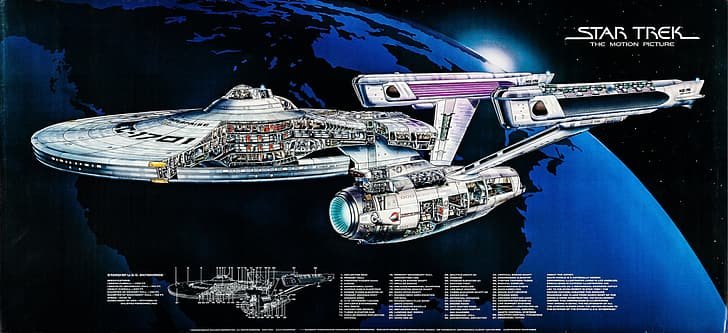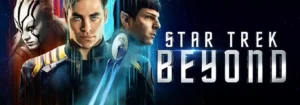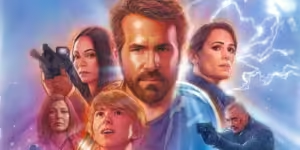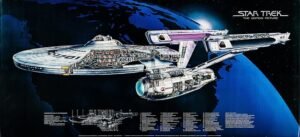
“`html
Introduction to Star Trek: The Motion Picture
Released in December 1979, Star Trek: The Motion Picture marked a significant milestone in the Star Trek franchise. As the first feature film adaptation of the renowned television series created by Gene Roddenberry, it bridged the gap between the original TV series and the ensuing array of movies and TV adaptations that expanded the universe. This film reintroduced audiences to the legendary crew of the USS Enterprise, setting the stage for future adventures and continuing the legacy of a cultural phenomenon that began in the 1960s.
At the heart of the story are familiar faces, including the indomitable Captain James T. Kirk, expertly portrayed by William Shatner, and the logical, ever-reliable Science Officer Spock, brought to life by Leonard Nimoy. Alongside them, the film features key characters from the original series such as Dr. Leonard “Bones” McCoy, Chief Engineer Montgomery Scott, Lieutenant Uhura, Sulu, and Chekov. Their camaraderie and chemistry remain essential to the dynamic of the film, as they undertake a journey that tests their skills and resolves like never before.
The plot revolves around an enigmatic and potentially destructive entity known as V’Ger, posing a grave threat to Earth. As the Enterprise crew comes together to confront this new challenge, they must rely on their intelligence, resourcefulness, and unity to uncover the mystery and thwart the impending danger. Throughout the film, themes of exploration, identity, and the quest for knowledge resonate deeply, capturing the essence of Star Trek’s optimistic vision of the future.
In essence, Star Trek: The Motion Picture served not only as a continuation of the beloved narrative but also as a foundational piece that enriched the Star Trek lore. It bridged the past with the future, paving the way for subsequent adventures that would continue to captivate audiences for generations to come.
The Herald of an Unknown Threat
As the narrative of “Star Trek: The Motion Picture” begins, an enigmatic and overpowering entity named V’Ger emerges as an imminent threat to Earth. V’Ger, shrouded in mystery, advances through space with a force so potent that it annihilates every obstacle in its trajectory. This stark reality introduces a growing sense of urgency and tension, as the escalating crisis demands immediate action.
The Federation, confronted with the looming peril, musters the best crew of the USS Enterprise to undertake a perilous mission to intercept V’Ger. The mission is laden with significant risks and uncertainties, underscoring the enormity of the task at hand. Precise decisions and unyielding resolve become imperative as Captain James T. Kirk, alongside his trusted officers including Spock and Dr. McCoy, leads the charge into the unknown.
This initial setup of the movie not only crafts an atmosphere thick with suspense but also foregrounds the gravity of the situation. The Enterprise crew, renowned for their valor and intellect, carry the immense responsibility of safeguarding Earth. As they embark on their mission, the palpable tension underscores the stakes both personally and globally.
Moreover, the enigmatic nature of V’Ger adds an additional layer of intrigue and mystique. It is not merely a straightforward antagonist but a complex and powerful entity whose motives and origins provoke intense curiosity and speculation. This intricately woven threat serves as the fulcrum around which the story pivots, setting the stage for the ensuing exploration, discovery, and confrontations that define the narrative arc of “Star Trek: The Motion Picture.”
Reassembling the Iconic Crew
The anticipation and excitement surrounding “Star Trek: The Motion Picture” are profoundly rooted in the reassembling of the iconic crew of the USS Enterprise. At the forefront is Captain James T. Kirk, whose passion for command drives him to retake the helm from Captain Decker. Kirk’s resolute dedication to his crew and the mission is palpable, epitomizing his transformation from the television series to the cinematic landscape.
The return of Mr. Spock, the half-human, half-Vulcan science officer, adds a layer of emotional complexity and intrigue. Spock’s evolution reflects his struggle with identity and the teachings of Vulcan logic, which contrasts sharply with the more emotional responses of Captain Kirk. Their dynamic friendship, marked by mutual respect and occasional tension, remains a central theme as the crew reassembles to face a colossal and enigmatic threat.
Reuniting with Dr. Leonard “Bones” McCoy, the ship’s irascible yet deeply compassionate Chief Medical Officer, further emphasizes the sense of nostalgia. McCoy, often the voice of moral reasoning, balances Spock’s logic and Kirk’s decisiveness. His return is not without its tensions, as his skepticism about the mission and its perils brings into sharp relief the gravity of the crew’s undertaking.
Other familiar faces—such as communications officer Uhura, helmsman Sulu, navigator Chekov, and chief engineer Scotty—each contribute to the collective strength and unity of the Enterprise. Their shared history creates a foundation of trust and camaraderie, necessary for the arduous journey ahead.
The palpable nostalgia woven through these reunions is underscored by subtle yet significant character evolutions. The crew’s progression from television to the big screen is marked by richer character development and heightened narrative stakes. As they prepare to embark on their mission, both old rivalries and deep-seated loyalties come to the fore, painting a vivid picture of their collective journey.
The Journey Begins
The journey of the USS Enterprise begins with an urgent mission to investigate a highly mysterious and potentially dangerous entity known as V’Ger, which is making its way toward Earth. As the crew embarks on this critical mission, they are met with an array of stunningly advanced special effects that were revolutionary at the time of the film’s release. The breathtaking visuals, from the grand expanse of space to the intricate details of the spacecraft, play a pivotal role in setting the tone of awe and wonder that characterizes the entire adventure.
From the onset, there is an undeniable tension and sense of looming danger, a testament to the film’s masterful direction and visual storytelling. The crew is not only tasked with deciphering the nature of V’Ger but also with confronting their own vulnerabilities and uncertainties. The grandeur of the unknown, juxtaposed with the cutting-edge technology of the Enterprise, creates a rich tapestry of exploration that captures the imagination.
Interpersonal dynamics among the crew members add another layer of complexity and intrigue to the narrative. Captain James T. Kirk, Admiral at the beginning of the story, resumes command of the Enterprise, leading to notable friction with its current captain, Willard Decker. Their interactions, tinged with tension and mutual respect, reflect the inherent challenges of leadership and responsibility. Meanwhile, the reintroduction of Spock, who has been undergoing a personal quest on Vulcan, further stirs the pot, bringing both his unparalleled intellect and emotional distance into the mix.
Minor conflicts and character developments are woven seamlessly into the larger narrative. These moments provide depth to the characters and underscore the high stakes of their mission. As the Enterprise draws closer to V’Ger, the crew must navigate not only the external perils of space but also the internal struggles and ethical dilemmas that define their journey. The convergence of advanced special effects, narrative depth, and character interplay creates a compelling beginning to their odyssey through the stars.
Encounters and Mysteries
As the USS Enterprise ventures deeper into uncharted space on its mission to intercept the enigmatic entity known as V’Ger, the crew faces a series of increasingly strange and perilous encounters. These challenges test their resilience and ingenuity, adding layers of suspense to their journey.
One of the pivotal moments occurs when the Enterprise encounters a massive energy field that emanates from V’Ger, signaling the start of their direct engagement with its mysteries. This force field poses a significant threat, requiring the crew to utilize all their technological expertise to navigate through it without sustaining critical damage.
Suspense heightens as a powerful probe from V’Ger infiltrates the starship, conducting a thorough scan of its systems and personnel. The probe eventually captures Lieutenant Ilia, a key member of the crew, and whisks her away to an unknown fate. The subsequent discovery that Ilia has been replaced by a mechanized duplicate—a perfect, yet inhuman, replica—deepens the mystery surrounding V’Ger. This artificial Ilia serves as V’Ger’s mouthpiece, communicating its enigmatic objectives while retaining the memories and consciousness of the original Ilia, creating a complex emotional challenge for the crew, particularly for her personal acquaintance, Commander Decker.
Moreover, the encounter with entities and phenomena of such advanced nature requires not just technological prowess but also quick, intelligent problem-solving. Captain Kirk, Mr. Spock, and Dr. McCoy, as the principal decision-makers, must stay one step ahead to protect their crew and ship. Spock’s attempt to meld with V’Ger, a desperate maneuver to understand its intentions and resolve the crisis, exemplifies the crew’s willingness to undertake significant risks for the greater good.
These experiences serve to underscore the growing dangers the Enterprise faces as it draws nearer to V’Ger, emphasizing the complexity and unpredictability of this interstellar journey. Each encounter not only propels the narrative forward but also strengthens the relationships and resolve of the crew, preparing them for the ultimate confrontation with the enigmatic entity.
The Revelation of V’Ger’s Origins
The pivotal moment in “Star Trek: The Motion Picture” comes with the revelation of V’Ger’s origins, a critical discovery uncovered by Captain Kirk and his crew. V’Ger, initially identified as an immensely powerful and enigmatic alien entity, is soon discovered to be the transformed Voyager 6, a space probe launched by NASA in the 20th century. The probe was presumed lost, only to be encountered and modified by an advanced alien race. These beings, fascinated by its mission to gather knowledge, heightened its capabilities, thus setting the stage for V’Ger’s extraordinary journey across the cosmos.
This revelation profoundly impacts the characters, particularly Spock, who grapples with V’Ger’s pursuit of understanding and connection. Spock’s intense desire to comprehend the enormity of V’Ger’s consciousness leads him to undergo a Vulcan mind meld with the entity, during which he learns of its origins and quest to reunite with its creator. Spock’s discovery is a catalyst for a significant shift in the narrative, offering a deeper philosophical insight into the nature of intelligence, identity, and the yearning for purpose.
The crew’s newfound understanding of V’Ger challenges their perceptions of life and consciousness. This modified probe’s solitary quest for its creator evokes parallels with humanity’s own search for meaning and knowledge. For Spock, this encounter becomes a transformative experience, emphasizing the interplay between logic and emotion. V’Ger’s inability to comprehend human-like affections or motivations without the incorporation of its creator’s guidance underscores the profound difference between synthetic enhancement and the inherent nuances of organic life.
Ultimately, the exploration of V’Ger’s origins enriches the film’s narrative, providing a multifaceted perspective on the complexities of evolution, technology, and the intrinsic drive for self-awareness. It beckons viewers to ponder the limitless potential of space exploration and the unforeseen consequences that technologies of today might face in their journey through time and space.
The Climactic Confrontation
At the heart of Star Trek: The Motion Picture lies the climactic confrontation between the crew of the USS Enterprise and the enigmatic entity known as V’Ger. This encounter necessitates that the crew leverage all their collective skills and knowledge, transcending technological barriers to communicate with a sentient being that perceives existence through an entirely different lens.
This moment is charged with both emotional and philosophical depth, exploring themes of technology, humanity, and existence. The crew, led by Captain Kirk, is pushed to the brink as they struggle to understand V’Ger’s motives and intentions. The unfolding drama intensifies when it becomes evident that the stakes are nothing less than the potential annihilation of Earth.
Central to this confrontation is the debate surrounding technology’s role in shaping humanity. V’Ger, initially a machine probe of human origin, has evolved into a self-aware entity seeking its creator. This evolution prompts discussions among the crew, particularly between Captain Kirk, Spock, and Decker, about the essence of life and consciousness. Spock’s interactions with V’Ger emphasize the need for logic and understanding, while Decker’s emotional connection offers a counterpoint, highlighting the human qualities of empathy and compassion.
The confrontation reaches its zenith when Decker elects to merge with V’Ger, symbolizing the union of human sentiment and advanced technology. This act of self-sacrifice conveys profound messages about the potential harmony between humanity and its creations. The fusion of Decker and V’Ger not only pacifies the threat but also signifies a new beginning, embodying the aspirations and hopes of a future where coexistence and mutual understanding can transcend existential boundaries.
Ultimately, this intense climax underscores the enduring themes of Star Trek: the quest for knowledge, the significance of human values, and the persistent exploration of what it means to exist in a universe teeming with possibilities. As V’Ger transforms into a new entity, it leaves both the crew and the audience contemplating the limitless potential of human ingenuity and the pursuit of interstellar journeys.
The Aftermath and Legacy
The resolution of Star Trek: The Motion Picture left a profound impact on its characters and the Star Trek universe as a whole. After the dramatic confrontation and the successful mission, the crew of the USS Enterprise emerged transformed, both individually and collectively. Captain James T. Kirk’s leadership was reaffirmed, bolstering his iconic status within Starfleet and among fans. Spock’s internal struggle between his logical Vulcan side and human emotions shifted, signifying a pivotal moment of self-acceptance. Dr. McCoy, Lieutenant Uhura, and the rest of the crew also experienced personal growth, enriched by their shared trials and triumphs.
The film’s contribution to the franchise transcended the narrative. Its pioneering special effects set new industry standards, with visual techniques that brought unprecedented realism to space travel and alien encounters. This technological leap resonated particularly with audiences who were experiencing the infancy of the blockbuster era. In addition to its visual accomplishments, the film delivered a compelling story that expanded the Star Trek mythos, incorporating complex philosophical themes about identity, purpose, and the essence of humanity.
This cinematic venture marked a new direction for future Star Trek adventures. It reinvigorated the series, paving the way for successive films and television series that continued to explore deep space and complex narratives. The film’s success cemented Star Trek’s status as a cultural phenomenon, inspiring a dedicated fanbase whose passion and creativity sustain the franchise to this day.
Star Trek: The Motion Picture is not merely a chapter in the expansive Star Trek saga; it is a cornerstone that has shaped the direction of science fiction storytelling. Its rich legacy endures, urging fans and newcomers alike to revisit or witness for the first time its remarkable blend of pioneering effects, gripping storylines, and the enduring spirit of exploration that defines Star Trek.



